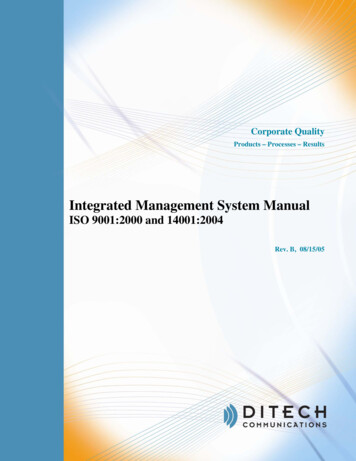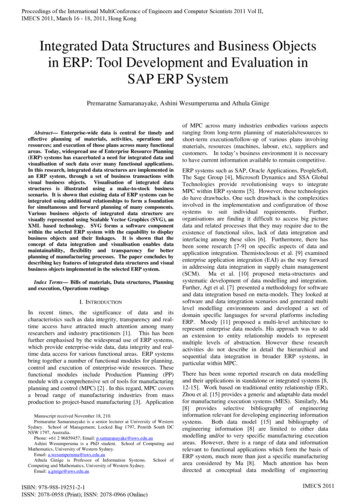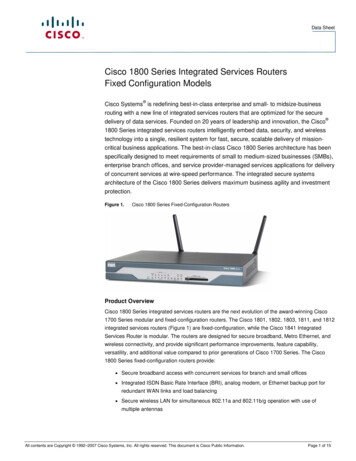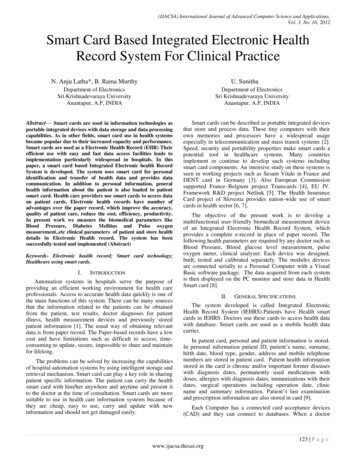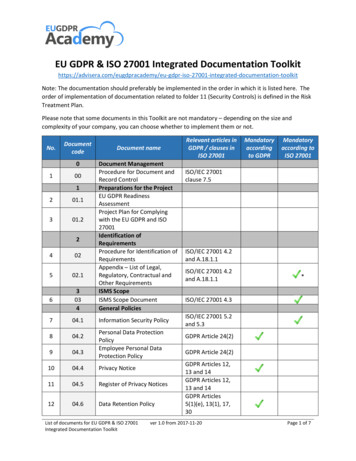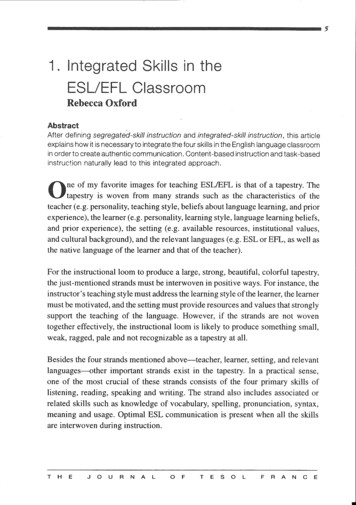
Transcription
1. Integrated Skills in theESL/EFL ClassroomRebecca OxfordAbstractAfter defining segregated-skill instruction and integrated-skill instruction, this articleexplains how it is necessary to integrate the four skills in the English language classroomin order to create authentic communication. Content -based instruction and task-basedinstruction naturally lead to this integrated approach.ne of my favorite images for teaching ESLIEFL is that of a tapestry. Thetapestry is woven from many strands such as the characteristics of theteacher (e.g. personality, teaching style, beliefs about language learning, and priorexperience), the learner (e.g. personality, learning style, language learning beliefs,and prior experience), the setting (e.g. available resources, institutional values,and cultural background), and the relevant languages (e.g. ESL or EFL, as well asthe native language of the learner and that of the teacher).OFor the instructional loom to produce a large, strong, beautiful, colorful tapestry,the just-mentioned strands must be interwoven in positive ways. For instance, theinstructor's teaching sty Ie must address the learning sty Ie of the learner, the learnermust be motivated, and the setting must provide resources and values that stronglysupport the teaching of the language. However, if the strands are not woventogether effectively, the instructional loom is likely to produce something small,weak, ragged, pale and not recognizable as a tapestry at all.Besides the four strands mentioned above-teacher, learner, setting, and relevantlanguages-other important strands exist in the tapestry. In a practical sense,one of the most crucial of these strands consists of the four primary skills oflistening, reading, speaking and writing. The strand also includes associated orrelated skills such as knowledge of vocabulary, spelling, pronunciation, syntax,meaning and usage. Optimal ESL communication is present when all the skillsare interwoven during instruction.THEJ0URNALoFTESOLFRANCE
The Idea of Language-as-SkillsLiteracy-as well as language itself-is sometimes viewed as a set of skills.According to Barton (1994), the skill image is a well-known, school-basedmetaphor. In this metaphor, "these skills are ordered into a set of stages .and then taught in a particular order. Literacy is seen as a psychologicalvariable which can be measured and assessed. Skills are treated as things whichpeople own or possess; some are transferable . , some are not. Learning to readbecomes a technical problem, and the successful reader is a skilled reader. As aschool-based definition of literacy, this view is very powerful, and it is one whichspills over into the rest of society." (pp. 11-12)Although I adopt some parts of the language-as-skills idea, I reject others. Forinstance, I agree that it is possible to assess the language skills (e.g. O'Malley &Valdez Pierce, 1996). However, I do not think that the language-as-skills conceptnecessarily implies that language skills are divisible into clearly defined stagesthat should be taught in a particular order. Likewise, I do not think that learningto read (or to use language in general) is merely a technical problem, nor that askill is something that one "possesses" like a baseball glove or a TV. Instead, Iview the main skills (listening, reading, speaking and writing) and the associatedskills (syntax, vocabulary and so on) as overlapping areas of competence.The "skill strand" of the tapestry leads to optimal ESL communication whenthe skills are interwoven with each other during instruction. This is knownas the integrated-skill approach.If this kind of coordinated weaving does not occur, then the strand consists merelyof discrete, segregated skills-parallel threads that do not touch, support, orinteract with each other. This is sometimes known as the segregated-skill approach.Another title for this mode is the language-based approach, because the languageitself is the focus (language for language's sake). In this approach, the emphasis isnot on learning language for authentic communication.By comparing segregated-skill instruction with integrated-skill instruction, wecan see the advantages of integrating the skills and move toward improving ourteaching for our English language learners.THEJOURNALoFTE SOLFRANCE
Segregated-Skill InstructionIn the segregated-skill approach, the mastery of discrete language skills likereading or speaking is seen as the key to successful learning, and there istypically a separation of language learning from content learning (Mohan, 1986;Cantoni-Harvey, 1987). This situation contradicts the integrated way that peopleuse language skills in normal communication, and it clashes with the direction inwhich language teaching experts have been moving in recent years.Skill segregation is reflected in traditional ESLIEFL programs that isolatelanguage skills for instructional purposes. These programs offer classes with titlessuch as "Intermediate Reading," "Basic Listening Comprehension," "AdvancedWriting," "Grammar I and II," "Pronunciation," and so on. Why do ESLIEFLprograms offer classes that segregate the language skills? For one thing, teachersand administrators might think it is logistically easier to present courses onwriting divorced from speaking, or on listening severed from reading. For anotherthing, they may believe it is instructionally impossible to concentrate effectivelyon more than one skill at a time.Even if it were possible effectively and fully to develop one or two skills inthe absence of all the others (and this is a highly dubious undertaking), suchan approach does not ensure adequate preparation for later success in academiccommunication, career-related language use, or "on-the-street" interaction inthe language. An extreme example is the Grammar-Translation Method, whichteaches students to analyze grammar and translate (usually in writing) from onelanguage to another. This method restricts language learning to a very narrow,non-communicative range that does not prepare students to use the language foreveryday life. Recently some ESLIEFL teaching candidates went to Venezuelafor a required, six-week cultural and linguistic immersion experience. Theyvisited universities and schools, where they found some English classes taught bythe Grammar-Translation Method and others taught in a broadly communicativemode. The candidates' journals and final papers reflected their conviction thatthe Grammar-Translation Method, the ultimate in skill segregation, was highlylimited in value for most of the Venezuelan students.THEJOURNALoFTE SOLF RANCE
Frequently segregated-skill ESLI EFL classes present instruction in tenns ofskill-linked learning strategies: reading strategies, listening strategies, speakingstrategies, and writing strategies (for examples, see Peregoy & Boyle, 2001).Learning strategies are behaviors or thoughts that students employ, most oftenconsciously, to improve their learning. Examples are guessing based on thecontext, breaking a sentence or word down into parts to understand the meaning,and practicing the language with someone else.Very frequently, experts demonstrate strategies as though they were linked toonly one particular skill such as reading or writing (e.g., Peregoy and Boyle,2001; Tierney et aI., 1999; Vacca and Vacca, 1993). However, it can be confusingor misleading to believe that a given strategy is associated with only one specificlanguage skill. Many strategies, such as paying selective attention, self-evaluating,asking questions, analyzing, synthesizing, planning and predicting, are applicableacross skill areas (see Chamot & O'Malley, 1994; Oxford, 1990). Commonstrategies help weave the language skills together. Teaching students to improvetheir learning strategies in one skill area can often enhance perfonnance in alllanguage skills (Oxford, 1996).In many instances, an ESL or EFL course is labeled by a single skill, butfortunately this segregation of language skills might be only partial or mighteven be illusory. If the teacher is creative, a course bearing a discrete-skill titlemight actually involve multiple, integrated skills. For instance, in a course on"Intennediate Reading" the teacher probably gives some or all of the directionsorally in English, thus causing students to use their listening ability to understandthe assignment. In this course students might discuss their readings, thusemploying speaking and listening skills and certain associated skills such aspronunciation, syntax and social usage. Students might be asked to summarizeor analyze readings in written fonn, thus activating their writing skill. In a realsense, then, some courses that are labeled according to one specific skill mightactually reflect an integrated-skill approach after all.The same can be said about ESLIEFL textbooks. For instance, a particulartextbook series might highlight certain skills in one book or another, but allthe language skills might nevertheless be present in the tasks in each book.In this way, students have the benefit of practicing all the language skillsTHEJ0URNA loFTESOLF RANCE
an integrated, natural, communicative way even if one skillfocus of a given volume.IIIISthe mainIn contrast to segregated-skill instruction, both actual and apparent, there areat least two forms of instruction that are clearly oriented toward integratingthe skills.Two Forms of Integrated-Skill instructionThe two types of integrated-skill ESLIEFL teaching are content-based languageinstruction and task-based instruction. The first of these emphasizes learningcontent through language while the second stresses doing tasks that requirecommunicative language use. Both of these benefit from a diverse range ofmaterials, textbooks and technologies in the ESL or EFL classroom.Content-Based InstructionIn content-based instruction, students practice all the language skills in a highlyintegrated, communicative fashion while learning content such as science,mathematics, and social studies (Crandall, 1987). Content-based languageinstruction is valuable at all levels of proficiency, but the nature of the contentmight differ by proficiency level. For beginners, the content often involves basicsocial and interpersonal communication skills, but past the beginning level, thecontent can become increasingly academic and complex. The Cognitive AcademicLanguage Learning Approach (CALLA, created by Chamot & O'Malley, 1994)shows how language learning strategies can be integrated into the simultaneouslearning of content and language.At least three general models of content-based language instruction exist:theme-based, adjunct, and sheltered (Scarcella & Oxford, 1992). The theme-basedmodel integrates the language skills into the study of a theme (for example, urbanviolence, cross-cultural differences in marriage practices, natural wonders of theworld, or a broad topic such as "change"). The theme must be very interestingto students and must allow a wide variety of language skills to be practiced,always in the service of communicating about the theme. This is the mostuseful and widespread form of content-based instruction today, and it is foundin many innovative ESL and EFL textbooks. In the adjunct model, languageand content courses are taught separately but are carefully coordinated. In theTHEJ0URNALoFTESOLFRANCE
sheltered model, the subject matter is taught in simplified English tailored tostudents' ESLfEFL proficiency level.Task-Based InstructionAnother mode of skill integration is task-based instruction in which studentsparticipate in communicative tasks in ESL or EFL. Tasks are defined as activitiesthat can stand alone as fundamental units and that require comprehending,producing, manipulating or interacting in authentic language while attention isprincipally paid to meaning rather than form (Nunan, 1989).The task-based model is beginning to influence the measurement of learningstrategies, not just the teaching of ESL and EFL. As the author of the original"Strategy Inventory for Language Learning" (or SILL, first published in Oxford,1990), I am currently leading a research group in developing a "Task-BasedSILL." This new questionnaire allows students to assess their own learningstrategy use as related to specific language tasks.In task-based instruction, basic pair work and group work are often used toincrease student interaction and collaboration. For instance, students work togetherto write and edit a class newspaper, develop a television commercial, enactscenes from a play, or take part in other joint tasks. More structured cooperativelearning formats can also be used in task-based instruction. Task-based instructionis relevant to all levels of language proficiency, but the nature of the tasksvaries from one level to the other. Tasks become increasingly complex at higherproficiency levels. For instance, beginners might be asked to introduce each otherand share one item of information about each other. More advanced studentsmight do more intricate and demanding tasks such as taking a public opinion pollat school, the university, or a shopping mall.I advocate a combination of task-based and theme-based instruction in whichtasks are unified by coherent themes. This combination is becoming a trendin ESLfEFL instruction.Advantages of the Integrated-Skill ApproachThe integrated-skill approach, as contrasted with the purely segregated-skillapproach, exposes ESLfEFL learners to authentic language and challenges themTHEJ0URNALoFTESOLFRANCE
to interact naturalistically in the language. In the integrated-skill approach,learners rapidly gain a true picture of the richness and complexity of the Englishlanguage as employed for communication. Moreover, the approach stresses thatEnglish is not just an object of academic interest nor merely a key to passing anexamination; instead, English becomes a real means of interaction and sharingamong people. This approach allows teachers to track students' progress inmultiple skills at the same time. Integrating the language skills also promotesthe learning of real content, not just the dissection of language forms. Finally,the integrated-skill approach (whether found in content-based or task-basedlanguage instruction or some hybrid form) can be highly motivating to studentsof all ages and backgrounds.Integrating the language SkillsIn order to integrate the language skills in ESLIEFL instruction, teachers shouldconsider taking these steps:Learn more about the various ways to integrate language skills inthe classroom (e.g., content-based, task-based, or a combination).Reflect on their current approach and evaluate the extent to whichthe skills are integrated.Choose instructional materials, textbooks and technologies thatpromote the integration of listening, reading, speaking and writingas well as the associated skills of syntax, vocabulary and so on.Even if a given course is labeled according to just one skill,remember that it is possible to integrate the other language skillsthrough appropriate tasks.Teach language learning strategies and emphasize that a givenstrategy can often enhance performance in multiple skills.With careful reflection and planning, any teacher canand strengthen the tapestry oflanguage teaching andwoven well, learners can use English effectively for communication.ISRebecca l. Oxford, Ph.D., is director of Second Language Education at theUniversity of Maryland. In addition to other works, she edited the ESL textbook seriesTapestry Program (Oxford & Scarcella, 1992-1995; Oxford, 2000) and co-authoredThe Tapestry of Language Learning: The Individual in the Communicative Classroom(Scarcella & Oxford, 1992).THEJ0URNALoFTESOLFRANCE
ReferencesBarton, D. 1994. Literacy: An introduction to the ecology of written language. Oxford,UK: Blackwell.Cantoni-Harvey, G. 1987. Content-area language instruction. Reading, MA: AddisonWesley.Chamot, A.U. & O'Malley, 1.M. 1994. The CALLA handbook: Implementing the Cognitive-Academic Language Learning Approach. Reading, MA: Addison Wesley.Crandall, J. (Ed.) 1987. ESL through content-area instruction: Mathematics, science,social studies. Englewood Cliffs, NJ: Prentice Hall.Mohan, B. 1986. Language and content. Reading, MA: Addison Wesley.Nunan, D. 1989. Designing tasks for the communicative classroom. Cambridge, UK:Cambridge University Press.O'Malley, lM. & Valdez Pierce, L. 1996. Authentic assessment for English languagelearners: Practical approaches for teachers. New York: Addison Wesley.Oxford, R. 1990. Language learning strategies: What every teacher should know.Boston, MA: Heinle & Heinle.Oxford, R. (Ed.). 1996. Language learning strategies around the world: Cross-culturalperspectives. Manoa: University of Hawaii Press.Oxford, R. (Ed.). 2000. Tapestry Program. (2nd ed.). (Series of ESL textbooks). Boston:Heinle & Heinle.Oxford, R. & Scarcella, R. 1992-1995. Tapestry Program. (lst ed.) Boston: Heinle &Heinle.Peregoy, S.F. & Boyle, O.F. 2001. Reading, writing, and learning in ESL. New York:Addison Wesley Longman.Scarcella, R. & Oxford, R. 1992. The tapestry of language learning: The individual in thecommunicative classroom. Boston: Heinle & Heinle.Tierney, R., Readence, J., & Dishner, E. (Eds.). 1999. Reading strategies and practices:A compendium. (5th ed.). Boston: Allyn & Bacon.Vacca, R. & Vacca, 1. 1993. Content-area reading. (4th ed.). New York: HarperCollins.THEJ0URNALoFTESOLFRANCE
Language Learning Approach (CALLA, created by Chamot & O'Malley, 1994) shows how language learning strategies can be integrated into the simultaneous learning of content and language. At least three general models of content-based language instruction exist: theme-based, adjunct, and

